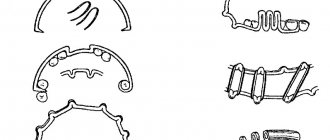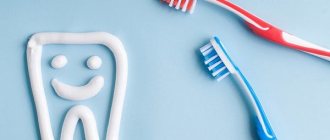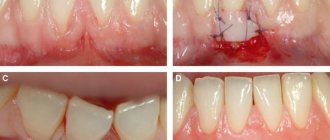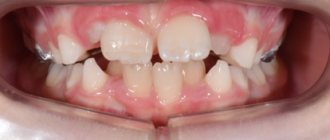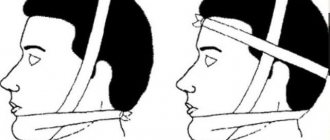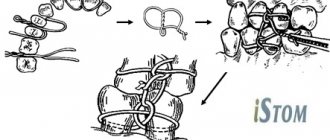Osteosynthesis is a surgical treatment for a jaw fracture , which involves the use of special, most often metal, plates to fix the fragments. The operation is performed in cases where connecting bone elements with a splint is difficult or impossible, or it is difficult to fix them in the correct position. In modern practice, several methods of jaw osteosynthesis using plates are used. The choice of a specific technique depends on the severity of the injury and its nature.
Plates for jaw fracture
The use of plates after a jaw fracture is justified when a conservative treatment method either does not give the desired result (correct reposition and high-quality fusion of bone parts) or cannot be used initially (complex injury). The decision to perform an operation is made by the doctor after examining the patient (examination if treatment methods other than surgery have already been used).
The advantage of bone osteosynthesis is that when plates are installed to connect fragments, the lesion site is well supplied with blood. This ensures fairly rapid fusion - in just a few weeks - while restoring the bone itself (integrity) and its anatomically correct structure.
How will your treatment proceed?
It is impossible to predict this, since all reactions, as well as the pain threshold, are individual. Some patients experience minimal discomfort, others experience pain, but only in the first days after activation of the system. Still others recall that discomfort, to one degree or another, accompanied up to half of the treatment time. For some, moving teeth itself is painful, but for others, just correcting the bite with traction rods is painful.
It should be noted that the type of braces (metal, ceramic, etc.) does not affect the degree of pain, since they work the same way. But aligners, by all accounts, are much more comfortable to wear. They are gentler than braces, especially at the beginning of treatment, so they almost never cause severe pain. In addition, due to their smooth surface, the aligners cannot scratch the inside of the lips and cheeks.
The aligners are smooth, follow the shape of the teeth, so they do not irritate the mucous membranes
Types of jaw osteosynthesis
Osteosynthesis with a metal plate for a jaw fracture is carried out in different ways. It is divided into types according to 2 characteristics - the method of fixing the plates and the technology of the operation itself.
- According to the method of fixing the plate for a jaw fracture, osteosynthesis can be: focal, when the elements of the plate are installed so as to cross the fracture gap and adjoin it;
- extrafocal, in which the plate is fixed outside the jaw fracture gap or passes through it above the mucous membrane and skin (without touching damaged tissues).
- open is carried out with dissection of soft tissues and “opening” of the ends of bone fragments (separation of the periosteum);
The closed method provides accelerated healing, since it does not involve complications that are possible due to impaired microcirculation in soft tissues. But the lack of visual control during closed osteosynthesis of the jaw makes it difficult to properly connect the bone elements and carry out the manipulation in general. This requires a very highly qualified specialist.
The open method of installing plates for jaw fractures (with visualization of the bone) makes it possible to most accurately compare the fragments, as well as remove damaged (interposed) soft tissues or small fragments of hard tissue. The main difficulty of the operation is the risk of tissue hypoxia, which is a common cause of enchondral osteogenesis.
The latter involves the transition of callus to the stage of cartilage, which is not typical for the lower jaw. With enchondral osteogenesis, the formation of a typical (ossified) callus of the lower jaw slows down.
Modern methods also include ultrasonic osteosynthesis with plates . It is carried out using special modern technology and is less traumatic. Installing plates for fractures using ultrasound equipment reduces the likelihood of complications.
How much does it hurt?
Most of the treatment time is pain-free. Typically, discomfort of varying severity occurs only in the first days after the start of treatment or activation of the system.
What severity of pain can there be at this time?
- Minor pain occurs when chewing and biting into hard foods (for example, meat or a chocolate bar). At the same time, eating soft food does not hurt.
- Aching pain with any food intake, even soft, but at rest nothing bothers you.
- Pain in the teeth and gums persists all the time, it is difficult even to drink water.
- The unpleasant sensations are accompanied by irritation of the mucous membranes of the lips and cheeks (sometimes this happens to those who wear braces, but not when wearing aligners).
- In addition to tooth pain, jaw joints may also hurt, and due to tension in the muscles of the face and neck, the head may also hurt. In rare cases, insomnia may occur.
Pain during bite correction is normal and usually goes away within 1–3 days.
Indications for osteosynthesis of the jaw with plates
The main indication for installing metal plates for osteosynthesis is the prevention of complications that cannot be effectively prevented by applying a traditional splint. In the case of osteosynthesis, an important task for the surgeon is to compare the fragments and fix them in the correct position. If successful, fusion will take up to 3–4 weeks.
Indications:
- fracture behind a row of teeth;
- inflammation that provoked injury;
- significant displacement of bone elements;
- high mobility of teeth at the fracture site;
- incorrect position of the jaws relative to each other.
What is a joint splint
They belong to trainers; silicone or elastic polyurethane are used for their manufacture. The design has the shape of a U-shaped arc, the dimensions are selected individually. It is very important to choose the correct size at your first visit, as this has a strong impact on wearing comfort.
The design of the tire has a special tongue stop on the sides, which allows you to control its position. Protection against tongue biting is provided by a small front tongue.
Kinds
The splints used for treatment are divided into the following types:
- single-jaw, that is, used to correct only one jaw;
- double-jawed, used for the treatment of bruxism, with pathological trauma to the enamel layer.
During treatment, the splint is placed between the jaws, controlling their position and modeling the bite. The elasticity of the material reduces stress on the surface of the teeth, reduces friction and reduces the overall load on joints and muscles. Shock-absorbing properties can reduce the symptoms of arthrosis and get rid of phenomena such as mouth breathing and bruxism.
Treatment with a splint involves its use for at least one hour during the day, the total duration is from 1-6 months, depending on the pathology. The direction of correction and duration of treatment is determined only by the dentist; you cannot interrupt wearing the splint yourself. To improve the effect, physiotherapeutic procedures, ointments or tablets may be prescribed.
Tires are available in various types, the most popular being low-slung all-day tires. They fit very tightly to the dentition and do not interfere with normal speech articulation at all. The silicone is transparent, almost invisible, and comfortable to wear. There are models that must be immersed in hot water before use. This way they adhere better to the surface of the teeth and provide greater effect.
Rules of care
| Click to sign up for a FREE consultation |
The structure requires careful care, for which it must be removed and washed with a toothbrush and regular toothpaste. The paste can be replaced with a special solution; the tire must be stored in a special container, which preserves its transparency, flexibility and extends its service life.
It is also necessary to take into account that during routine visits to the doctor, a small grinding of all protruding parts may be required, according to the bite. In some cases, instead of sanding, additional layers are applied if the dentist deems it necessary.
Installation
Installation of plates for a jaw fracture using the open method is carried out in 4 stages:
- a soft tissue incision is made to visualize and connect the fragments;
- connecting bone fragments using a plate;
- fixation of bone elements with glue, staples, quick-hardening plastics used in modern surgery;
- suturing.
The main difficulty of open surgery is trauma. The doctor works with the area in which the nerve endings and salivary glands are located, which creates the risk of damage to them, and therefore determines high requirements for the qualifications of the specialist.
A safer and less traumatic method is ultrasonic osteosynthesis of the jaw. It not only reduces the risk of complications during fixation, but also reduces the time for fracture healing.
Rubber bands for splinting
In some cases, splinting with wire requires additional fastening with special rubber bands to fix the jaws in a closed state. The main purpose of the rubber bands is to move the teeth in the direction in which they were originally. There are many advantages of elastic material:
- The rubber bands are easy to cut and remove, which is especially important if the patient has suffered a head injury and there is a risk of complications in the form of epileptic seizures, fainting and other neurological disorders.
- With the correct tension, the elastic bands allow you to take food through a tube; a tighter fastening often leads to tube feeding.
- Damaged rubber bands can be easily replaced, while damage to the metal structure will require serious medical intervention.
The decision to install rubber bands for splinting must be made by a doctor and most often they begin to be used only when primary healing of the injured jaw has occurred. In the first stages, as a rule, more rigid fixation is required. In any case, consultation with a specialist is required, who, based on the condition of the teeth, the nature of the damage, and the general condition of the patient, will be able to determine the most suitable type of splinting. Dr. Sadov’s clinic in Moscow employs professionals who have completed internships abroad and clearly understand the specifics of dental orthopedics.
Recovery after surgery
Rehabilitation after installation of a titanium plate for a jaw fracture takes 6 months. The specific recovery time depends on how much time has passed from the moment of injury to treatment, as well as on the patient’s age, his condition, the severity of the injury, and the method of osteosynthesis.
Rules during rehabilitation:
- immediately after the manipulation, a bandage is applied for fixation; it must be worn constantly;
- it is important to exclude any movements (talking, chewing, opening and closing the mouth);
- drug rehabilitation involves taking a course of antibiotics and restoratives, the drugs are selected individually and prescribed by a doctor;
- for recovery, the patient is prescribed decongestant and anti-inflammatory physiotherapy (from day 2 - UHF, from day 4 - magnetic therapy, after 2 weeks you can start a course of electrophoresis);
- classes in LVF (therapeutic and restorative physical education) begin 3–5 weeks after removing the fixing bandage, their goal is to restore normal speech function, normalize chewing, and facial expressions.
For the entire recovery period after installation of a plate for a fracture, the patient is prescribed a diet (liquid meals, purees, strictly at room temperature, taken through a straw). Solid food is introduced into the diet gradually after the bandage is removed and chewing functions are restored.
To avoid complications, it is important to maintain good oral hygiene. You can brush your teeth only after removing the bandage and restoring mobility, so in the first weeks hygiene comes down to rinsing your mouth, which should be done up to 10 times a day (including after each meal).
How to eat after splinting
Hard splinting involves difficulties in eating, but at the same time, during this period it is especially important for the body to receive a large amount of vitamins, minerals, and nutrients required for the speedy regeneration of bone tissue. The patient's menu after splinting usually includes various nutritious broths, fruit, vegetable and meat purees (baby purees), semi-liquid and liquid porridges. It is necessary to monitor the content of large amounts of protein, calcium, phosphorus, and zinc in food. It is possible to replace some meals with infant formula or sports nutrition, since in both cases the content of substances necessary for the body is high.
It is strictly forbidden to drink any alcoholic beverages during treatment, especially if, in addition to the jaw, there is also a traumatic brain injury. In addition, you should not try to eat solid foods that require chewing. Firstly, it can cause severe pain. Secondly, it can lead to improper healing of damaged bone tissue.
If you receive injuries that have symptoms similar to a jaw fracture: acute pain, bleeding, immobilization of the jaw, and so on, you should immediately seek professional help. Attempts at self-treatment or complete lack of treatment cause irreparable harm and lead to loss of dental functionality.
Rehabilitation
This is the most important stage in the treatment of fractures, since prolonged immobilization leads to atrophy and circulatory disorders. Complications may develop - thrombosis, venous stagnation and lymphostasis.
The recovery period begins shortly after surgery and consists of two stages.
- Stationary. The patient takes medications, and after the pain stops, he is prescribed movement therapy and exercise therapy.
- The outpatient period begins after the patient is discharged home and can last up to a year. This depends on the complexity of the fracture and the treatment method chosen. There are no universal tips here, since each patient has his own rehabilitation program. The common goals are: Restoration of blood circulation;
- Elimination of muscle atrophy;
- Restoration of motor function.
An effective way to successful rehabilitation is reasonable physical activity. This process helps to overcome the patient’s somewhat constrained independent movements. Their positive effect is obvious. Each patient needs to exercise, gradually increasing the load so that the exercise does not cause discomfort.
Comments
After installing the splint, is the patient allowed to go home or does he have to stay in the hospital?
Mike (06/26/2020 at 02:41 pm) Reply to comment
- It all depends on the nature of the injury, accompanying symptoms and the condition of the victim. If a person is unconscious, has fractures and injuries to other parts of the body, then he needs observation and specialized care, which can only be provided in a hospital.
Editorial staff of the portal UltraSmile.ru (06/29/2020 at 09:14) Reply to comment
A very unpleasant phenomenon. I wonder what to do with food for forty days. That is, the patient is unable to chew or take solid food at all. Will this have a negative impact on the digestive system if food comes in liquid form for several months?
Sergey Petrovich (07/23/2020 at 08:50) Reply to comment
How long do the consequences of a fracture of the lower jaw last? What I mean is that at the site of any fracture a certain callus appears. And how long does it usually take to make itself felt after an injury?
Vladimir Logvinov (07/23/2020 at 09:06) Reply to comment
Is it true that after a jaw fracture, this place becomes so vulnerable that if you put a little pressure on it, say, cracking a nut, and a second fracture will immediately occur?
Nikolay (07/23/2020 at 09:22) Reply to comment
Surely, after all, there are consequences from a fracture of the lower jaw, even if surgery and rehabilitation are performed, or only in difficult cases do there remain any consequences?
Lera (07/23/2020 at 09:30) Reply to comment
My husband broke his lower jaw when he hit himself at work. Now he is in the hospital, and through a bunch of bandages on his face, it seems to me that he did not have a very successful operation. What are the consequences if the operation is not performed correctly? Can this be fixed immediately before it is too late?
Zhanna (07/23/2020 at 10:24 am) Reply to comment
During a fight, along with a broken jaw, teeth are often damaged. Are there any contraindications to installing metal-ceramic implants after a jaw fracture has been healed?
Evgeniy (07/23/2020 at 14:37) Reply to comment
It’s very interesting whether this has ever happened in medical practice, when there are no obvious symptoms of a jaw fracture, but there is still a fracture? And is it possible to fully recover after a fracture, without any consequences?
Svetlana (07.23.2020 at 14:46) Reply to comment
Good afternoon My brother has had more than 21 days of rehabilitation, but his jaw is not healing well, the doctor reassures him that everything will heal, but we are worried. Tell me, should I worry or should I expect a full recovery?
Victor (07/23/2020 at 15:26) Reply to comment
Write your comment Cancel reply
Can the upper jaw break?
Maybe, but doctors admit that this is a very rare situation. Due to anatomical features and lack of mobility, even in the most complex accidents, the upper jaw often remains intact. However, experts also emphasize that when the upper jaw is damaged, the symptoms and consequences are much stronger, they more often lead to death.
A fracture of the upper jaw is much more serious and dangerous than the lower jaw
The mandibular bone is massive and mobile, protrudes forward, therefore, with any external influence on it, it “suffers” first of all. According to statistics, it is damaged in 80% of cases of the total number of injuries to the bones of the facial skeleton.
